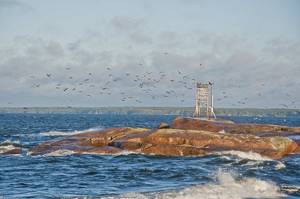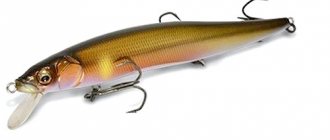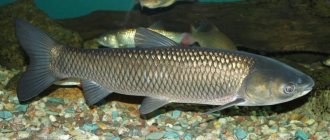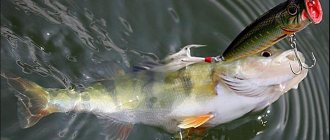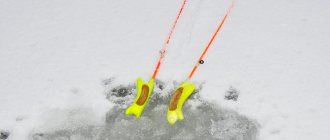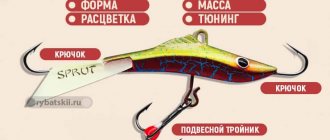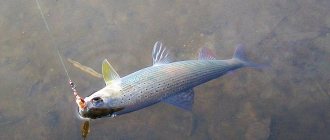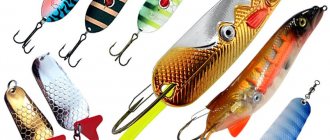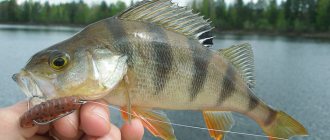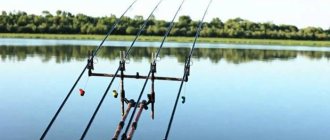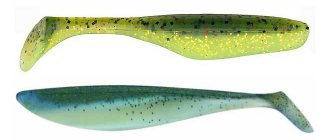Population and behavioral characteristics
Let us note right away: the pike perch of the Gulf of Finland does not have any pronounced behavioral features. If you are familiar with the habits and preferences of this fish, then there can be no secrets for you here. You can read about the description of the habits of this fish and its way of life in this section. Separately, we note that in the Gulf of Finland a ban on pike perch fishing is introduced annually; it is usually valid until June 15. The ban falls during the spawning period.
Previously, pike perch had commercial importance, and it still does, but not on such a scale. Although this fish is found quite often, it is worth recognizing that commercial fishing, as well as poachers, have had an extremely negative impact on the pike perch population in the Gulf of Finland.
Today it is extremely rare to catch a pike perch weighing more than 3-3.5 kilograms, and catching specimens weighing more than five kilograms is considered a great success. But small pike perch, up to 1.5 kilograms, is found quite often.
How to catch perch in big water
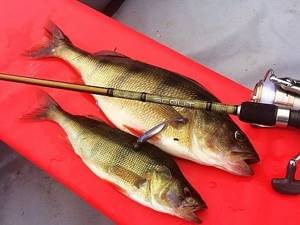
Photo by the author. In this fishing, I am especially attracted to the remote banks of the Gulf of Finland and Lake Ladoga. On hot summer days, when the weather is especially favorable, and all other predators take a short time out before the autumn start, it is the perch that becomes the main prey.
However, it’s not only in the summer that perch fishing can be successful. There are periods in spring and autumn when you can secure a rich catch. It is no secret that perch is a fairly active predator, it moves a lot, gathering in numerous schools. The purpose of this is to search for concentrations of small fish, and in this its behavior is exactly the same in any place and at any time.
But in the coastal zone of large bodies of water, the size of the striped fish rarely exceeds 500 grams. Using UL gear you can quite enjoy this kind of fishing, because during daylight hours the number of bites realized can exceed a hundred. However, in deep water, further from the shore, the perch is noticeably larger and much more interesting to catch.
CHARACTERISTIC SITES
Now I have verified points, but this was not always the case. It is a known fact that perch loves to hunt at relatively shallow depths with a rocky bottom. And there are quite a lot of such stone shoals and banks in the Gulf of Finland and Ladoga. There are even entire rocky archipelagos that form small straits.
Such islands are usually called “gull islands”, since many waterfowl, primarily gulls and cormorants, nest on them. These same places attract small fish. Moving away from the shore creates more comfortable conditions, the water is better saturated with oxygen, there is no flowering effect (as in the coastal part), there are natural shelters for small things, currents and powerful landfalls. Similar conditions apply to banks.
|
| A very attractive place for fishing. Photo by the author. |
First of all, it is important to monitor the direction of the wind. A surge wind, which increases the water level, is a more favorable period than a “squeeze” period, during which the water level drops. Otherwise, it is always better to take a leeward position. But if the wind is strong enough and the waves in the water area are noticeable, it is better to go to the islands, taking cover behind them. On such days, in open areas the probability of getting a large number of bites is quite small.
Calm is considered not the best time for fishing. I can't agree with this completely. On hot days, especially in the second half of summer, when the temperature difference between day and night becomes significant, windless days turn out to be quite favorable times.
Read the material “Where to fish with jerk”
Typically, in the bay, perch rarely hunts close to the surface, so it does not visually reveal its presence. Unlike Ladoga and Onega, where so-called perch boilers appear during the same period, in the bay you will have to spend a little more time searching for fish. Not only knowledge of the water area, but also a good echo sounder can make the task much easier.
FISHING FEATURES
It took a lot of time before I managed to choose the most successful scheme. I started, like many others, with spinners, then wobblers came into use. There was a result, but the count was in the dozens, and even then on the best days.
It turned out that soft baits are more to the taste of striped fish. And the ratio at certain moments is simply indecently superior. Taking into account the food supply, the most effective bait is 5–7 cm long. Depths at the fishing site range from 1.5 to 4 meters, but perch usually hunts in the upper third or half of the water. I rarely use a jig head weighing more than 5 grams and do not see much point in using various complex equipment.
But not all rubber works the same. The color of the bait is very important. Natural colors work best, as well as dark ones - olive and “machine oil”. Much worse are bright, fluorescent ones.
Read the material “How to catch a perch with a vibrotail”
Wiring is carried out in the middle layers, like a spinner. The pace of the posting is slow and uneven. Most bites happen during a pause. You can make small twitches with the rod, but not too sharp. In most cases I control the pace of the retrieve with the reel. It must be said that once in a place where fish accumulate, the perch will not give much time to retrieve; the attack occurs within 10–15 seconds after casting.
When the fish were especially active, I tried to move the bait evenly or more aggressively - in both cases the number of bites was significantly reduced.
The classic jig is practically ineffective. There is very little perch at the bottom, but there is a lot of mud, which quickly covers both the bait itself and even part of the fishing line with a carabiner, and therefore further wiring no longer makes sense.
TACKLE BOX
The perch grabs the bait quite greedily, without requiring hard hooks. Taking into account the given conditions, I use a UL spinning rod with a test weight of up to 10 g and a length of 2.13 m. Although in cases where there is a high chance of catching a very large perch or pike, I can arm myself with a more powerful spinning rod. With a length of 2.6 meters, it allows you to throw a light bait to the required distance. The action of the rod in both cases is medium-fast. For me this is the most comfortable combination.
The fishing line raises much more questions. Most of my friends use thin cords. In this case, the color of the braid matters. It is best to put green or brown. But I am more conservative in my views and prefer a regular monofilament with a diameter of 0.22 mm. I didn’t keep any special statistics, but at the level of sensations – there are still more bites with fishing line.
In deep water, perch is not the most desirable trophy for most spinners, but if you catch a striped fish weighing more than 1.5 kg, it will be remembered for a long time. And in terms of resistance, it can easily outperform pike and pike perch of comparable size, although the main charm of such fishing is its dynamics. It is enough to find a feeding place and just enjoy the process.
Read the material “How to catch a predator with a microjig”
My friends who are fans of winter perch fishing claim that it is impossible to release it in winter, as if it will scare away the school. I don’t know how true this is, but in the summer there are definitely no problems with this. We usually take a few large fish for smoking or evening fish soup on the shore, while the rest go to their native elements. And in my practice there were at least three cases of repeated captures within just half an hour.
Dmitry Matveev July 30, 2021 at 08:45
Where to catch walleye in the Gulf of Finland?
Every experienced fisherman has his own places that he will tell few people. It is known that when fishing for pike perch, an echo sounder can be of great help, as it will show the bottom topography and help you find this fish. By the way, we have a separate section about echo sounders, where there is a lot of interesting information. However, there are known areas that are best for walleye fishing.
Vyborg Bay
It is considered one of the best places (as is the adjacent water area). There are often changes in depth, shallows, and pitfalls - pike perch loves such places. And he has a sufficient food supply here. But here you need to look for pike perch; in the Vyborg Bay it rarely stands in one place, actively moving in search of prey. That is, if you find a catchable place, it is far from a fact that in a week (or even the next day) there will be a good catch here.
It lives at depths of 10+ meters, but in the hottest months it can approach the shore to depths of up to 5 meters. At the end of the summer it moves to deeper places, and by mid-autumn it is already being searched for at depths of more than 15 meters.
Resort area
Here pike perch are caught by trolling at depths of about 5 meters. You need to look for areas of the bottom with rocky soil. However, large specimens are quite rare here. Here you also need to actively look for pike perch.
Dam
It is also caught in the area of the dam of the Gulf of Finland, and the great depths allow it to be caught directly from the shore. They use bottom fishing rods and spinning rods. Objectively speaking, the places for catching pike perch here are not bad, but very popular. There are always a lot of fishermen here.
Islands
There are quite a few islands in the Gulf of Finland; you can read about the most interesting and largest ones in this section. The largest pike perch are caught near the remote islands, the only problem is that they are remote and it is not easy to get to them. It definitely won't work on a rubber boat.
You can find maps on the Internet that show good places, but, in our opinion, you shouldn’t trust them too much.
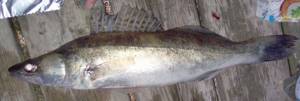
What happens at the bottom and what does the fisherman see while fishing?
For clarity, consider a diagram (diagram No. 1), which shows a section of the river in cross section. The casting occurs from the right (relative to us) bank perpendicular to the river flow. The jig bait in the figure is moved from left to right.

The diagram shows examples of the most characteristic and interesting reliefs of the river bottom. It is divided into sections and marked with letters. Let's look at how the bait behaves on each of them.
A-B. Shallow coastal area with a slight increase in depth. It is characterized by a fast flow. The bottom is sandy, without silt. Often covered with areas of shell rock, single stones and bushes of underwater vegetation. The predator does not stay in this area all the time, but periodically comes out to hunt numerous fry. Absolutely any predatory fish can become prey for a spinning rod in this area: pike perch, pike, perch, asp, chub, etc. But you shouldn’t expect them to peck constantly in this place - the predator enters this area at the peak of its activity (the so-called "exit").
In any case, you should start fishing from this area (if the distance allows you to cast). You can throw a jig head weighing 18-24 grams at 60-100 meters.
What happens when the bait reaches the bottom in section A-B ?
As always, the tip of the spinning rod signals a fall: it shudders and straightens. Then it begins to bend again - this current pulls on the “cord”-line going to the bait. The angle at which the “cord” goes into the water is sharp and in order to tear the bait off the bottom you need to make a sharp jerk of the spinning rods upward and turn the reel several times at maximum speed. As a rule, in these areas the current speed is very high and during the time it hangs, the bait is carried several meters to the side. Having fallen to the bottom, it can continue to move for some time by inertia and under the influence of water, clinging and hitting underwater obstacles (shell rocks, stones, holes in the sand, etc.). The tip of the spinning rod conveys this to us as shudders and blows. How can you distinguish a real bite from collisions with obstacles at this moment? It’s hard to say... Over time, you begin to distinguish and identify all the signals, but at first it’s better to make a short sweep with each similar blow, just in case.
The next section is a drop from shallow water to depth B-V .
The area is very attractive for fishermen - it is a hunting ground. Very often, predators who have gone out to hunt “graze” at the very upper boundary of the dump. In this case, a bite often follows on the very first free fall of the jig bait. This place is very promising and should be given special attention. When passing through this zone, impacts on stones and shell rocks usually stop, and the intervals between touching the bottom increase - this indicates that the bait is falling from the slope of the underwater “slide”. In this case, the number of reel revolutions and reeling speed can be reduced - the bait easily comes off the slope and flies down. Such places are the best for performing “steps”. A bite in this area should be expected at any time, since the predator can move along the slope, both in the horizontal and vertical plane.
One of the unpleasant aspects of this section is the bottom debris. Quite often, it is on such steep slopes that blockages of logs, branches and other debris form. On the one hand, this creates additional cover for the predator and increases the chances of catching it, but on the other hand, numerous hooks can greatly thin out our fishing arsenal.
The bottom section V-G is a resting place for the predator. A correctly presented bait can provoke him to grab. This place should also not be ignored, especially in the absence of fish “exit”.
In the diagram, section V-D is shown as small. In fact, it can be quite extended. The angle at which the line goes into the water is quite large, and the large mass of water helps the bait come off the bottom, so the “step” in this area is of high quality. The exception is the moment when the jig bait approaches the beginning of the rise ( point G ). Here our line rests on the top of the hill ( point D ) and the “step” becomes impossible. The bait simply drags along the G-D .
G-D area is also a hunting ground for predators, but for us it has no prospects. There have been cases when a particularly hungry perch literally hung onto a bait crawling up the slope, but this is more an exception than a pattern. Therefore, when the bait reaches the G-D , it is better to reel in the cord until it reaches the top of the hill. When the bait crawls up the slope, the tip of the rod bends and the angler feels heavy, as if there is debris hanging on the bait. But upon reaching the top of the underwater spit, this heaviness disappears and the bait continues to “play”.
Section D-E is the top of the underwater spit. The place is very interesting for a fisherman. It is located next to the predator’s permanent camp sites and at a considerable distance from the coast. A predator's bite can be expected both at the very top of the hill and on the slopes from it.
Section E-Zh is a deep dump. In terms of its characteristics and wiring technique, it is similar to section B-B (see above).
Section Zh-Z – river bed. This is a parking and resting place for a predator. White fish also settle here: bream, large roach, and bream. The activity of the predator in this area depends on the season and time of day. As a rule, fish gather at depth during the cold season. But besides this, there are many factors: atmospheric pressure, enrichment of water with oxygen, transparency, temperature, etc., which can affect the bite of a predator in channel pits. Therefore, on every fishing trip, you need to pay attention to deep places and navigate according to the situation, in practice determining in which part of the reservoir the predator is hunting today.
From the editor: I have had some annoying mistakes in practice. Having chosen a familiar hole on the river, which had repeatedly pleased me with standard and even trophy catch, I “shot” it with a jig for several hours. I changed the bait, the speed of the retrieve, the weight of the jig heads, but I couldn’t get the slightest bite... Unable to bear it, I moved several tens of meters downstream and changed the fishing area. In our diagram it is designated A – B – C , i.e. shallow water area with transition to depth. From the very first casts, when the bait fell from the “edge” down, a school of active pike perch was discovered. Within a few minutes, about 10 confident bites followed, some of which were successfully realized. Having asked the question: “What was this – the “exit” of a predator?, I moved to the old place, but again did not see a single bite... A few days later, these areas “switched places”, and the hole pleased with the results, and the shallow dump was “silent”...
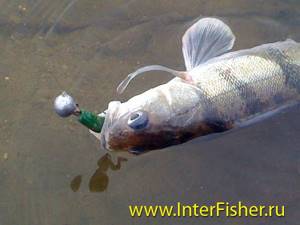
Continuation:
Section Z – I – rise from depth to shallow water. Another hunting zone for a predator, as well as a place where all kinds of garbage are concentrated. It is this area that often becomes the reason for the unfortunate disappearance of a large predator. Caught in previous sections, he strives to find shelter and “rests his forehead” on this rise. If he manages to get behind a stone or snag, the fisherman has practically no chance of pulling out the prey.
Bites in this area are quite frequent, but a technical problem often arises. If the rise from the depths is too sharp, then it is not possible to complete a full-fledged “step” - the “cord”-line lies on the “edge” (point I ), and the bait drags along the slope. If the slope is fairly flat, then the wiring may work, especially since the angle at which the “cord”-line goes into the water in this area already becomes obtuse. This helps the bait to come off the bottom when reeling in.
And the last section K - L - coastal shallow water from the angler's side. Its characteristics are similar to section A–B (see above). The only difference is that on approaching the shore, the line goes into the water almost at a right angle and practically does not float in the current. The weight of the jig head, which worked well in deep water, turns out to be too much in shallow water. Therefore, the free fall time is very short. In this case, a bite is not excluded, but if you want to fish this area more thoroughly, it is better to replace the bait with a lighter one.
The diagram does not show all the options for bottom relief. There are more complex areas, with pits, smooth drops into the depths, sand spits coming to the surface, whirlpools with reverse flow, and others. We wanted to talk about the basics of jig fishing. With time and practice, the angler begins to understand the bottom relief in a given section of the river (“read the bottom”). The sound with which the load touches the ground determines its composition (stone, sand, silt). But it is impossible to learn this in theory. Therefore, the best jig-spinning school is located on the river bank. Go fishing more often and the deepest fishing secrets will be revealed to you!
What to use to catch pike perch?
Pike perch is caught using various baits, the most popular being oscillating spoons and wobblers. Vibrating tails, jigs and balancers are also used. There is no single recipe for success here; it is recommended to have different baits in your arsenal. But judging by the reviews, wobblers show the best results. On the forums you can even find the top 10 wobblers for pike perch in the Gulf of Finland, however, all these ratings are very arbitrary.
It is worth taking into account the diet of this fish and selecting bait that matches this diet. In the Gulf of Finland, pike perch feed mainly on ruff, gudgeon, and bleak. If we summarize all the opinions about the best artificial baits for pike perch, we get the following picture:
- The optimal size of wobblers is from 6 to 8 centimeters;
- You should choose long and narrow spinners, up to 10 centimeters;
- The color is better monochromatic, but depends on the type of bottom.
In addition, a lot depends on the depth at which you catch walleye. If the depths are more than 10 meters, then you should choose bright baits, perhaps even with fluorescence. Sometimes such baits with “acid” colors give excellent results when fishing for pike perch in the Gulf of Finland. But they are worth using when traditional ones do not produce results. According to all reviews, it is monochromatic baits that give the best results.
Here is a list of good wobblers and spinners, which, according to reviews, are good for catching pike perch in the Gulf of Finland:
- Yo-Zuri Hardcore;
- Mikado Trython;
- Kuusamo Professor.
As we mentioned above, having a fish finder dramatically increases your chances of success. Many fishermen who want to catch pike perch can often spend 90% of their time searching for a good place. But when they find it, all the time spent on the search is more than paid off with an excellent catch.
What is a light jig?
As already mentioned, the division into heavy and light jig-spinning is quite arbitrary, but it is dictated by fishing practice. And although these two species have much in common, there are also many fundamental differences that do not allow them to be combined into a single fishing method.
In shallow areas of rivers and lakes, it makes no sense to use heavy loads. Despite the apparent convenience - long casting and a more distinct “tapping” of the bottom, excessively heavy loads can have a bad effect on the action of the bait, alarming and frightening the fish.
When fishing along coastal and underwater vegetation, as well as on the edges and dumps of lakes and ponds, we rarely use long-distance casting. As a rule, 30 - 40 meters is enough, and sometimes 10 - 15 meters is enough. In these conditions, casting accuracy and correct placement of the bait are much more important.
In this case, the weight of the jig head is 3 – 10 grams. This is quite enough to deepen the bait by 1 - 3 meters and make a so-called “step” in the water column .
The fishing technique in this case completely coincides with the bottom “step”, the only difference being that we do not let the bait sink to the bottom, but force it to glide up and down. The idea is the same - to demonstrate to the predator that an easy prey is trembling in front of his nose with all his might.
This technique is best suited to areas with a rocky bottom, snags or “windows” among aquatic vegetation. In this case, in a limited space, we can offer the predator a very tempting wiring, because the twister or vibrating tail “plays” not only in the horizontal plane, but also when rising and falling. Sometimes it is this technique that brings the long-awaited bite.
In clear, shallow water areas, light jig baits can also be used to make bottom “steps.” The only thing is that the lighter the load, the weaker the tip of the spinning rod will “play back” when the bait touches the bottom. But this is not critical, since the fishing depth is not great and you can intuitively feel the moment the jig head falls.
Does not exclude light jig and even movement of the bait. Sometimes this is the only possible way of fishing. For example, when passing a jig through single reed stems or water lily leaves. The “step” in this case will lead to an inevitable hook, and the bait slowly bending around the plants can lure a lurking predator out of ambush.
But don’t forget that in fishing there are no right or wrong moves. You need to experiment, mix them together, speed up, pause, put the bait on the bottom, make it twitch with slight jerks, change the trajectory of movement, and so on. And this is the only way you will find an approach to the sometimes capricious and cautious predator.
In its technique, light jig is close to fishing with spoons and wobblers, and in this case the same gear is quite suitable. The only requirement is a more or less sensitive tip of the spinning rod. But this is not as important as in the case of a heavy jig, since the fishing depth is usually very shallow and the bite is transmitted “to the hand.”
From the editor: In practice, when fishing with light jig baits, you often have to focus on the behavior of the “cord”-line. During the pause, the bait glides at a very slow speed and the predator simply needs to pull it into its mouth without attacking. This behavior is especially typical for perch. The fisherman sees how the fishing line that was slack during the pause is slightly stretched or moves to the side. There is no blow or jerk, but after hooking a beautiful humpback perch or bass weighing half a kilo can powerfully hit the hook!
When to catch pike perch in the Gulf of Finland?
Fishing in winter
For pike perch in the Gulf of Finland, special rules apply when fishing in winter. If in summer it is found almost throughout the entire water area, then in winter the picture is completely different. At this time of year he prefers to stay away from the coast. Yes, sometimes it approaches the shores, but in certain places. These could be areas near the southern coast or the northern one; there is no particular point in indicating them, however: Repino, Sestroretsk, Old Peterhof, Sterna, Cape Gray Horse, Komarovo, Vyborg Bay. However, keep in mind that the picture may be different every winter. If you have success catching walleye in a certain area off the North Shore one winter, don't be surprised if they aren't there at all the next year.
By experience, winter fishing enthusiasts have determined the most catchy winter lures for pike perch in the Gulf of Finland. Here is a list of the most catchy ones (according to reviews):
- Kuusamo Tasapaino;
- Kuusamo Tasapaino Silver;
- Scorana Ice.
When winter fishing for walleye, the most important thing is to find a good spot. To do this, be prepared to walk on ice. There is no point in sitting at the first hole and waiting for fish.
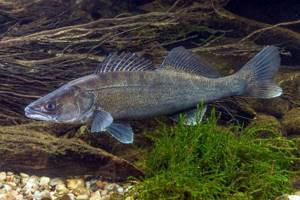
Fishing in spring
Please note that from mid-May there is a ban on catching pike perch. In general, spring is not the best time to catch this fish. In early spring it can be caught from the ice, but after the ice melts it may experience a decrease in activity. At the end of April, he begins to develop an appetite - pike perch actively hunts before spawning. At this time you can catch it during the day, evening, morning and even at night.
Fishing in summer
There’s not much to say about summer fishing for pike perch in the Gulf of Finland; we’ve written a lot about this above. The best time is morning from 4.00 to 8.00 and evening from 21.00 to 2.00. During the white nights, you can also fish late at night.
Fishing in autumn
Again, as we wrote above, in the fall pike perch goes to deep places, at which time catching it from the shore gives very poor results. You will definitely need a boat. The further into autumn, the deeper places you need to look. By the end of October these may be depths of more than 20 meters.
We also recommend reading the article: Fishing in the Gulf of Finland
Popular fishing spots
There is a special place in the bay - “Marquis's Lawn”.
It attracts many fishermen, young and old. This is a great place to spend a weekend or even stop by for a few hours after work. This is an ideal place for fishing. You can catch fish in the first few hours you spend near the pond. In winter, when the bay is frozen, roach bite well. The timing of fishing is important. Roaches will be better off taking bait at night. Knowing the behavioral characteristics of fish will play into your hands. In fishing, all the nuances are important, such as the habits of the fish and the preferred bait. It is better to catch schooling fish in a large school. In this case, for a good bite you just need to feed it.
The Gulf of Finland extends beyond Russia. Part of it is located in Finland. Fishermen planning to fish on the other side must have a foreign passport. But it has been verified that the bite here is no worse than abroad. Everyone will remember a holiday in the Leningrad region on the Gulf of Finland.
For many, the bay will look like a large lake. Natural conditions made it shallow with a large supply of fresh water. The water here is slightly salted - from 0.2 to 9.4%. The resulting water spaces were loved by many species of fish. They are also popular with fishermen, of whom there are always many on this body of water. The water surface covers almost 30 thousand square kilometers. The dam on the Gulf of Finland is a special place.
The dimensions of the bay are as follows: length 420 kilometers and width 70-130 kilometers. At the deepest point the bottom is 121 meters, and the average depth is about 38 meters. In winter, the water temperature is around zero, and in summer it rises to 17ºC. In the area of the bay bottom it is constant and amounts to 2-3ºC.
The reservoir becomes covered with ice in late November, and is freed from it only in April. There are winters without severe frosts, and then ice does not form on the surface of the bay. The east of the bay is the shallowest and is fenced off by a dam. It is worth knowing that there are places at the bottom that were buried by man.
The sandy beaches of the north of the bay have become a haven for many tourist centers and boarding houses with all amenities. At the same time, fishermen also fell in love with them, because here are the best fishing spots in the entire reservoir. In the north-west of the reservoir there are the greatest depths and steep banks. It is best to go fishing in June.
- Only on the dam you can profit from white fish (bream, silver bream or roach). For catching, bottom and float fishing rods and a feeder are used. Suitable baits include bloodworms, earthworms and maggots. Fish do not respond well to vegetable bait, so you should use bread, soaked grains or semolina for this purpose only as a last resort.
- In winter, fishing in the Gulf of Finland on the dam will be memorable. For this purpose, people come here as soon as the ice freezes. Smelt loves the resulting habitat conditions. Its local species will be the only one in the catches until spring. With the arrival of sunny days, Baltic smelt enters the Gulf of Finland. It is larger in size and has a slightly different taste.
- The Dudergovsky Canal has good banks, plenty of fish and convenient access. All this attracts amateur and professional fishermen from all over the northern capital. They catch roach, carp, perch and pike on the canal.
- The Strelna Yacht Club hosts not only yachts and athletes. There are a lot of fish and, of course, fishermen on its territory. Fish are caught all year round. You can see bream, perch, pike perch and roach on the hook. Everyone catches them in the way they like best.
- The Lakhtinsky Razliv is famous for its huge fish, which are not so easy to catch. Tricky fish can be caught using vibrating tails, spinners or spoons. Here you can catch perch, pike or pike perch.
- Bream are found in Lakhta, Olgino, the mouth of the Neva, near Vasilyevsky and Krestovsky islands and the coal harbor. Many fishermen like to lead roaches with a jig. Perch and pike perch also live in these places. It is also convenient to catch bream because it will definitely be in catchable places. Experienced fishermen know all the dates of the massive presence of fish in different places and seasons. For example, white bream will be caught in Olgino all winter. The most experienced ones are able to catch tens of kilograms of fish in one sitting. In spring, at the mouth of the Malaya Neva and Nevka there are schools of bream.
- Depth maps will help you find your own biting spot. They have been updated and contain a lot of relevant and useful information. With their help, you can get your bearings and correctly select the right bait and gear. Have a great time, connect with nature and enjoy a good catch! Go on vacation to the Gulf of Finland; its most attractive places are clearly visible on the map.
We suggest you read: Spinner fishing for beginners
